I've been screwing around with IBIS models lately and came across something that left me scratching my head. First, the generic model structure for the semiconductor portions of an IBIS I/O looks like the following (taken from this article):
When the I/O block is configured as high-impedance or as an input, the transistors are off and the clamps are the only thing that remain. However, the above diagram is a little misleading. Here is a clearer version of what it normally looks like (see Figure 5.2 in the IBIS Modeling Cookbook v4):
So what this means is the IBIS I-V data for the "GND Clamp" would include whatever explicit ESD diode is there (if any) along with the parallel parasitic diode across the NMOS transistor which is formed from its P-substrate being connected to Vss. Therefore, if there is no explicit ESD diode placed there by the IC designer, there will still be clamping through the parasitic diode. The same applies to the "Power Clamp" and the PMOS with its N-well connected to Vdd.
The IBIS model I was mainly working with is the io6_ft_3v3_mediumspeed from the stm32g030_031_041_so8n.ibs file found on ST's website. The part that got me is the [POWER_clamp] section. It's full of zeros, which indicates there's no clamping diode there, not even the parasitic one.
[GND_clamp]
|Voltage I(typ) I(min) I(max)
|
-3.30 -9.610100A -9.634600A -9.698600A
-2.11 -9.610100A -9.634600A -9.698600A
-2.04 -9.610100A -9.634600A -9.158000A
-1.97 -8.973800A -9.634600A -8.617600A
-1.90 -8.341900A -8.951300A -8.077300A
-1.83 -7.733800A -8.272900A -7.537400A
-1.76 -7.143900A -7.595000A -6.998200A
-1.69 -6.559900A -6.917200A -6.461500A
-1.62 -5.977000A -6.239600A -5.937600A
-1.55 -5.394600A -5.562200A -5.429900A
-1.48 -4.812700A -4.885200A -4.930600A
-1.41 -4.231200A -4.208600A -4.435000A
-1.34 -3.650600A -3.532600A -3.941100A
-1.27 -3.070900A -2.857500A -3.448600A
-1.20 -2.492700A -2.183700A -2.957600A
-1.13 -1.916700A -1.512300A -2.468800A
-1.06 -1.344600A -0.845620A -1.983200A
-0.99 -0.779760A -0.200210A -1.502600A
-0.92 -0.235540A -14.184000mA -1.030400A
-0.85 -26.063000mA -3.338100mA -0.574180A
-0.78 -4.498700mA -1.808500mA -0.166400A
-0.71 -1.722400mA -0.869590mA -29.450000mA
-0.64 -0.806710mA -0.283710mA -6.281100mA
-0.57 -0.298430mA -49.681000uA -1.756100mA
-0.50 -70.568000uA -4.410800uA -0.578090mA
-0.43 -10.478000uA -0.229130uA -0.180040mA
-0.36 -1.112700uA 0.0A -44.662000uA
-0.29 -94.335000nA 0.0A -9.039200uA
-0.22 0.0A 0.0A -1.572000uA
-0.15 0.0A 0.0A -0.247600uA
-0.08 0.0A 0.0A 0.0A
3.28 0.0A 0.0A 0.0A
|
[POWER_clamp]
|Voltage I(typ) I(min) I(max)
|
-3.28 0.0A 0.0A 0.123990uA
-0.12 0.0A 0.0A 0.123990uA
-0.08 0.0A 0.0A 0.0A
0.00 0.0A 0.0A 0.0A
|
This seemed impossible to me, so I then checked another IBIS file I had on my PC, which is for the Xilinx Spartan-6 (note: link requires an account). I looked at the model for the LVCMOS33_S_12_TB_33 and it's the same deal with that one too (all zeros for [POWER_clamp]):
[GND_clamp]
|Voltage I(typ) I(min) I(max)
|
-3.30 -18.6400A -15.5300A -21.8300A
-3.23 -18.0900A -15.0900A -21.1800A
-3.16 -17.5400A -14.6400A -20.5200A
-3.09 -16.9900A -14.2000A -19.8700A
-3.02 -16.4400A -13.7500A -19.2200A
-2.95 -15.8900A -13.3100A -18.5700A
-2.88 -15.3300A -12.8600A -17.9100A
-2.81 -14.7800A -12.4200A -17.2600A
-2.74 -14.2300A -11.9700A -16.6100A
-2.67 -13.6800A -11.5300A -15.9600A
-2.60 -13.1300A -11.0800A -15.3000A
-2.53 -12.5800A -10.6400A -14.6500A
-2.46 -12.0300A -10.2000A -14.0000A
-2.39 -11.4800A -9.7570A -13.3500A
-2.32 -10.9300A -9.3140A -12.7000A
-2.25 -10.3800A -8.8700A -12.0500A
-2.18 -9.8380A -8.4270A -11.3900A
-2.11 -9.2880A -7.9830A -10.7400A
-2.04 -8.7390A -7.5400A -10.0900A
-1.97 -8.1910A -7.0970A -9.4450A
-1.90 -7.6420A -6.6540A -8.7940A
-1.83 -7.0940A -6.2110A -8.1440A
-1.76 -6.5450A -5.7690A -7.4940A
-1.69 -5.9980A -5.3260A -6.8440A
-1.62 -5.4500A -4.8840A -6.1940A
-1.55 -4.9030A -4.4420A -5.5450A
-1.48 -4.3560A -4.0010A -4.8970A
-1.41 -3.8100A -3.5600A -4.2500A
-1.34 -3.2650A -3.1190A -3.6030A
-1.27 -2.7200A -2.6790A -2.9580A
-1.20 -2.1760A -2.2400A -2.3120A
-1.13 -1.6310A -1.8000A -1.6680A
-1.06 -1.0870A -1.3610A -1.0230A
-0.99 -0.5443A -0.9217A -0.3828A
-0.92 -0.1469A -0.4827A -0.1083A
-0.85 -64.7600mA -0.1469A -71.3400mA
-0.78 -41.6800mA -51.2700mA -54.5500mA
-0.71 -31.0500mA -34.3900mA -41.0300mA
-0.64 -21.9300mA -17.5100mA -30.7600mA
-0.57 -15.3100mA -11.9000mA -20.4900mA
-0.50 -8.6940mA -6.2810mA -11.9300mA
-0.43 -3.4430mA -4.2460mA -5.6830mA
-0.36 -0.9814mA -2.2110mA -1.9640mA
-0.29 -0.1546mA -0.1763mA -0.4145mA
-0.22 -17.5900uA -37.6600uA -56.4400uA
-0.15 -2.1280uA -6.7780uA -3.8740uA
-0.08 -0.4467uA -0.8458uA -0.4195uA
-0.01 -53.5100nA -95.4000nA -92.6400nA
0.06 -3.0910nA 40.8700nA -45.8200nA
0.13 3.2070nA 75.2100nA -28.1800nA
0.20 6.3220nA 83.7300nA -17.0700nA
0.27 8.6820nA 89.8100nA -8.7630nA
0.34 10.5700nA 92.3100nA -2.4280nA
0.41 11.9400nA 94.8100nA 3.9070nA
0.48 13.0400nA 97.2900nA 6.9870nA
0.55 13.8800nA 98.8700nA 9.0930nA
0.62 14.4000nA 0.1005uA 11.2000nA
0.69 14.6200nA 0.1020uA 13.3000nA
0.76 15.2900nA 0.1041uA 15.6000nA
0.83 15.8300nA 0.1064uA 17.2400nA
0.90 16.2800nA 0.1087uA 16.9900nA
0.97 16.5300nA 0.1106uA 17.7100nA
1.04 16.7800nA 0.1116uA 18.9500nA
1.11 17.0200nA 0.1150uA 19.4500nA
1.18 17.2700nA 0.1167uA 19.3100nA
1.25 18.5200nA 0.1178uA 19.9600nA
1.32 18.9600nA 0.1199uA 20.2200nA
1.39 20.0700nA 0.1215uA 21.9100nA
1.46 18.4500nA 0.1241uA 22.9500nA
1.53 19.6100nA 0.1257uA 23.3700nA
1.60 22.5700nA 0.1274uA -47.7600nA
1.67 22.1000nA 0.1296uA 91.7900nA
1.74 21.6300nA 0.1318uA 82.3900nA
1.81 22.2400nA 0.1340uA 13.3000nA
1.88 23.3300nA 0.1363uA -55.7800nA
1.95 24.4200nA 0.1387uA -62.6000nA
2.02 25.5200nA 0.1412uA -18.4200nA
2.09 26.6100nA 0.1436uA 25.7500nA
2.16 26.8400nA 0.1460uA 69.9300nA
2.23 26.6900nA 0.1483uA 0.1141uA
2.30 26.5400nA 0.1505uA 0.1100uA
2.37 26.3900nA 0.1527uA 66.5100nA
2.44 26.2400nA 0.1549uA 22.9700nA
2.51 27.0900nA 0.1570uA -20.5700nA
2.58 28.4100nA 0.1602uA -64.1100nA
2.65 29.7200nA 0.1633uA 26.7200nA
2.72 31.0400nA 0.1634uA 28.6600nA
2.79 32.3500nA 0.1639uA 28.2700nA
2.86 31.5100nA 0.1699uA 27.8800nA
2.93 32.2800nA 0.1831uA 28.9100nA
3.00 35.4900nA 0.1999uA 30.3000nA
3.07 34.6300nA 0.2342uA 31.6900nA
3.14 32.0300nA 0.3088uA 33.0700nA
3.21 32.4000nA 0.3163uA 34.4600nA
3.28 36.0600nA 0.2703uA 29.4900nA
|
[POWER_clamp]
|Voltage I(typ) I(min) I(max)
|
-3.30 0.0mA 0.0mA 0.0mA
-3.28 0.0mA 0.0mA 0.0mA
-3.24 0.0mA 0.0mA 0.0mA
-3.20 0.0mA 0.0mA 0.0mA
-3.16 0.0mA 0.0mA 0.0mA
-3.12 0.0mA 0.0mA 0.0mA
-3.08 0.0mA 0.0mA 0.0mA
-3.04 0.0mA 0.0mA 0.0mA
-3.00 0.0mA 0.0mA 0.0mA
-2.96 0.0mA 0.0mA 0.0mA
-2.92 0.0mA 0.0mA 0.0mA
-2.88 0.0mA 0.0mA 0.0mA
-2.84 0.0mA 0.0mA 0.0mA
-2.80 0.0mA 0.0mA 0.0mA
-2.76 0.0mA 0.0mA 0.0mA
-2.72 0.0mA 0.0mA 0.0mA
-2.68 0.0mA 0.0mA 0.0mA
-2.64 0.0mA 0.0mA 0.0mA
-2.60 0.0mA 0.0mA 0.0mA
-2.56 0.0mA 0.0mA 0.0mA
-2.52 0.0mA 0.0mA 0.0mA
-2.48 0.0mA 0.0mA 0.0mA
-2.44 0.0mA 0.0mA 0.0mA
-2.40 0.0mA 0.0mA 0.0mA
-2.36 0.0mA 0.0mA 0.0mA
-2.32 0.0mA 0.0mA 0.0mA
-2.28 0.0mA 0.0mA 0.0mA
-2.24 0.0mA 0.0mA 0.0mA
-2.20 0.0mA 0.0mA 0.0mA
-2.16 0.0mA 0.0mA 0.0mA
-2.12 0.0mA 0.0mA 0.0mA
-2.08 0.0mA 0.0mA 0.0mA
-2.04 0.0mA 0.0mA 0.0mA
-2.00 0.0mA 0.0mA 0.0mA
-1.96 0.0mA 0.0mA 0.0mA
-1.92 0.0mA 0.0mA 0.0mA
-1.88 0.0mA 0.0mA 0.0mA
-1.84 0.0mA 0.0mA 0.0mA
-1.80 0.0mA 0.0mA 0.0mA
-1.76 0.0mA 0.0mA 0.0mA
-1.72 0.0mA 0.0mA 0.0mA
-1.68 0.0mA 0.0mA 0.0mA
-1.64 0.0mA 0.0mA 0.0mA
-1.60 0.0mA 0.0mA 0.0mA
-1.56 0.0mA 0.0mA 0.0mA
-1.52 0.0mA 0.0mA 0.0mA
-1.48 0.0mA 0.0mA 0.0mA
-1.44 0.0mA 0.0mA 0.0mA
-1.40 0.0mA 0.0mA 0.0mA
-1.36 0.0mA 0.0mA 0.0mA
-1.32 0.0mA 0.0mA 0.0mA
-1.28 0.0mA 0.0mA 0.0mA
-1.24 0.0mA 0.0mA 0.0mA
-1.20 0.0mA 0.0mA 0.0mA
-1.16 0.0mA 0.0mA 0.0mA
-1.12 0.0mA 0.0mA 0.0mA
-1.08 0.0mA 0.0mA 0.0mA
-1.04 0.0mA 0.0mA 0.0mA
-1.00 0.0mA 0.0mA 0.0mA
-0.96 0.0mA 0.0mA 0.0mA
-0.92 0.0mA 0.0mA 0.0mA
-0.88 0.0mA 0.0mA 0.0mA
-0.84 0.0mA 0.0mA 0.0mA
-0.80 0.0mA 0.0mA 0.0mA
-0.76 0.0mA 0.0mA 0.0mA
-0.72 0.0mA 0.0mA 0.0mA
-0.68 0.0mA 0.0mA 0.0mA
-0.64 0.0mA 0.0mA 0.0mA
-0.60 0.0mA 0.0mA 0.0mA
-0.56 0.0mA 0.0mA 0.0mA
-0.52 0.0mA 0.0mA 0.0mA
-0.48 0.0mA 0.0mA 0.0mA
-0.44 0.0mA 0.0mA 0.0mA
-0.40 0.0mA 0.0mA 0.0mA
-0.36 0.0mA 0.0mA 0.0mA
-0.32 0.0mA 0.0mA 0.0mA
-0.28 0.0mA 0.0mA 0.0mA
-0.24 0.0mA 0.0mA 0.0mA
-0.20 0.0mA 0.0mA 0.0mA
-0.16 0.0mA 0.0mA 0.0mA
-0.12 0.0mA 0.0mA 0.0mA
-0.08 0.0mA 0.0mA 0.0mA
-0.04 0.0mA 0.0mA 0.0mA
|
This got me starting to wonder how it's possible to disable the parasitic diode in the PMOS transistor. I did some digging...first in the datasheet, which mentions the power clamp diodes only operate in the context of a PCI interface. That pointed me to the SelectIO User Guide, but the only clue I scrounged up was in a completely unrelated section regarding interfacing with Open-Drain circuits:
There are interesting things going on behind that PMOS transistor, with terms a non-IC designer like me has never heard before, such as "floating N-well" and "well bias". It's a very good clue, and since I cannot find good information on either of these terms, it brings me to my question(s):
Is this a typical method of how the parasitic PMOS diode can be disabled...i.e. am I on the right track here? And if so, can someone explain how this floating N-well with its well bias is generally implemented and how it works? And if I'm not on the right track, how do IC designers achieve this behavior of having I/O's without any Power Clamps? Ideally, once I understand the fundamentals of how this all works, I would eventually like to implement an equivalent circuit in SPICE which can simulate how these parasitic PMOS diodes get side-stepped.
NOTE: That last part is simply the context I'm asking my question from (in case it helps). I'm not asking for a SPICE model or someone to build one.
